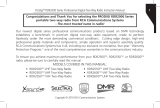
2
English
CONTENTS
Features ......................... 35
VoiceStorage...................... 35
VoiceRecorder.................. 35
EmergencyMessage ............. 38
Utilities . . . . . . . ................... 39
Scan.............................40
CallForward....................... 43
Talkaround........................ 44
Whisper..........................45
LoneWorker....................... 46
PowerLevel.......................47
Companding.......................48
Backlight.......................... 49
OptionBoard...................... 50
VoiceOperatedTransmit(VOX)....... 51
Stun/Unstun.......................52
RadioInformation ................. 53
SafetyInformation................. 55
SafeandEfficientOperation..........55
Exposure to Radio Frequency Energy . . . 55
Radio Operation and EME Exposure. . . . 56
Electromagnetic Interference/
Compatibility.......................56
OperationalWarnings................56
VehicleswithanAirBag............56
Potentially Explosive Atmospheres . . .56
Batteries........................56
Blasting Caps and Areas . . . . . . . . . . .57
OperationalCautions.................57
DamagedAntennas...............57
Batteries........................57
GeneralRadioCare..................57
Computer Software Copyright
The products described in this manual may include copyrighted computer
programmes stored in semiconductor memories or other media. Laws in the
United States of America and other countries preserve for Motorola Europe
and Motorola Inc. certain exclusive rights for copyrighted computer
programmes, including the right to copy or reproduce in any form the
copyrighted computer programme. Accordingly, any copyrighted computer
programmes contained in the products described in this manual may not be
copied or reproduced in any manner without the express written permission of
the holders ofthe rights. Furthermore, the purchase of these products shall not
be deemed to granteither directly or by implication, estoppel, or otherwise, any
licence under the copyrights, patents, or patent applications of the holders of
the rights, except for the normal non-exclusive royalty free licence to use that
arises by operation of the law in the sale of the product.





















